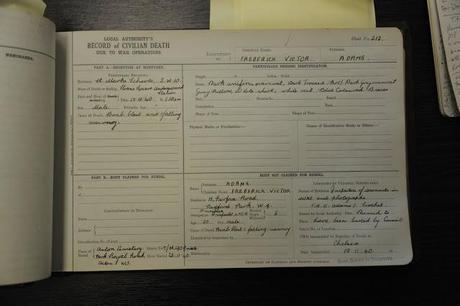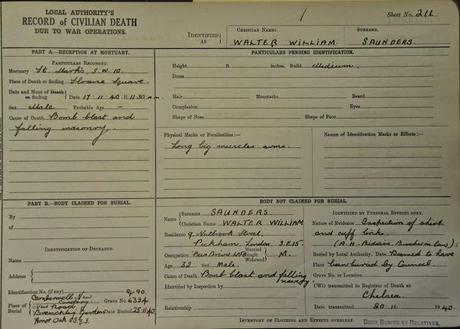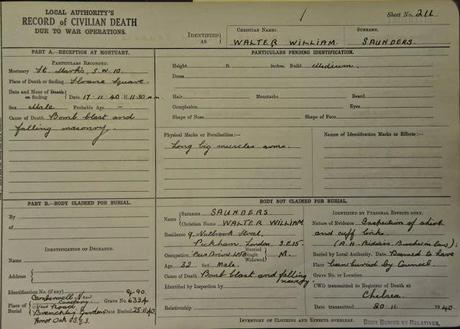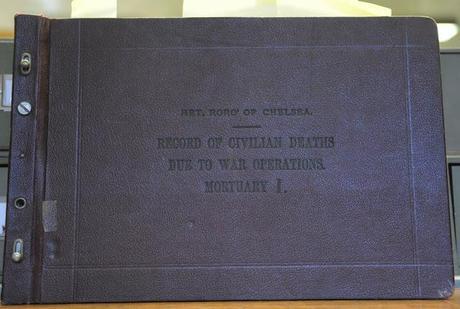In the aftermath of Remembrance Sunday, David does some digging and goes some way toward finding out why the Second World War still looms large in the lives of Londoners…
The biblical three score and ten.
A lifetime.
November 17, 1940.
And as long as we’re running the numbers, 70 hours or so on from Remembrance Sunday.
Yes, Remembrance Sunday. The squared away, across the board, orchestrated, all march one way, “uniform” solemnity.
And I’m not in any way deprecating “all that”. That good bye – the phrase means God be with you – to all that for another year.
All I’m saying is that this “personal” Remembrance – today, November 17, 2012 – is of a different order altogether. Whatever it is, this “personal” act of Remembrance isn’t formal solemnity. It isn’t officially decreed (and served up) solemnity. It isn’t all 60 million of us on the same page at the same time. solemnity.
What it is, is just one of us – me (and maybe in a few minutes, a few of you). And that word – solemnity – doesn’t begin to get it. What does get it – or at least come close – is stunned, hollowed out, zero-at-the-bone, something shifted. Something “oh Jesus” real. As opposed to something canned.
And this is the door I’ve opened, what I’m looking at – that’s had that effect on me.

It’s a Fosis binder.

One of three. One of them is about two inches thick. The other two are each about an inch thick. The first one – the big one – has 300 sheets in it. They’re numbered 1-300. The second one has 163 sheets, numbered, yes, 301-463. The third one is “more complicated” (for various reasons).
I’ve selected sheet No. 211 and sheet No. 212. Didn’t choose them at random. Though they could have been. The other sheets are all of a piece.
But, no, I didn’t pick them at random. I picked them because they’re the mortuary records of Walter William Saunders and Frederick Victor Adams, whose lives ended 70 years ago today.
But first, let’s think just for a minute about the matter of these records generally. The Greek root of the word history is enquiry. History is an enquiry. So let’s make an enquiry here. Using these records.
Take a look at 211. The “front page” of the William Walter Saunders mortuary record. And just for a minute remember that prior to November 17, 1940 that was just a form. It was a form that the government saw fit to draw up and circulate to mortuaries the length and breadth of the United Kingdom at the start of the war. That in itself tells you that civilians were dying – or were expected to – on an industrial scale. Had it been a rare occurrence there wouldn’t have any need for one-size-fits-all “forms” for the whole country…
And some of the particulars are fascinating in themselves. The “gendered” Personal Effects lists, for example. Apparently keys weren’t something that women carried very much in 1940. Or cigarette Lighters and Cigarette Cases. (Remember those old films – the gentleman always helping her with a light.?)
But now the time has come. Can’t avoid it any longer.
They “found” Walter William Saunders at 11.30 am on November 17, 1940. Well, they found what was left of Walter William Saunders. Not much more than a few “personal effects”. Notice that laconic final entry: “N.B. Clothing in shreds – remnants”.
Now if you can bear to, let me guide you through Sheet 211. Start with the neat handwriting of the mortuary clerk. It’s 70 years later and I’m just looking at the old records. No closer than that. And yet despite that “oh so safe remove” coming to terms with what I’ve seen between those two covers has been, yes, a zero at the bone experience.
So what must it have been like for that clerk in that mortuary? Who saw the real thing. Day after day. Night after night.
And did his duty. Did it, surely, because it was the very least the deceased – the men and women whose lives had been snuffed out –deserved.
The bomb that killed Walter William Saunders hit Sloane Square Underground station.
Look very closely at the first entry – PART A –RECEPTION AT MORTUARY. PARTICULARS RECORDED. I
Two particulars in particular. Two miniscule particulars. The form asks the clerk to put down an approximate age. PROBABLE AGE. That space is empty. Well, almost empty. There’s just the tiniest mark – like a dash. That’s the clerk dutifully noting, “no, I didn’t miss this – there was just no way of telling.” They couldn’t tell, on admission, whether Walter William Saunders was 18 or 88. Or, as it happened, 32.
And notice what the clerk has done with the Date and Hour of Death or finding entry. He’s dutifully crossed out the word Death and the word or. They found Walter William Saunders at 11.30 am. His friend and co-worker Frederick Victor Adams was “found” four hours later. There would have been hundreds of rescue service people and locals trying to clear away the rubble, find any survivors. That’s how utter the devastation was – it took four hours to get to Frederick Victor Adams. Death wasn’t what was in question – what was in question was when their “remains” were found.

And look again at the front page of the Saunders records. Just those four words in the entry for Physical Marks or Peculiarities:– “Long big muscles arms”. Is that how they knew he was a man?
Or was it – here you need to look at the second page – his personal effects.
2 cuff links
1 white vest
1 pair of white pants
1 blue shirt with a black stripe,
and marked lebel in collar,
‘BANNER’
WARRANTED BRITISH MADE.
I don’t know why, exactly, but that BRITISH MADE guts me. Yes, I know, it’s a shirt collar label. But, well, at no little risk of belabouring the obvious, WALTER WILLIAM SAUNDERS was also BRITISH MADE.
Something as well about the clerk’s doggedly – bravely even – getting it down in caps, just as it was there on collar, on the table, in the St. Mark’s SW 10 Mortuary on November 17, 1940.
Flip back over and you’ll see that Walter Saunders was “Identified by Personal Effects Only” ¬ by “inspection of shirt and cuff links” by his brother-in-law.
Think about that inventory again, if you can bear to: cuff links, white vest, white pants, blue shirt, a label in a collar”. No shoes. No socks. No trousers. Just his underwear and a shirt. And a muscled arm.
Well, I’ll leave you to make your own way through the Frederick Victor Adams record. Maybe just say that they were near contemporaries – 30 and 32 years old. And they both worked for LPTB. One was a bus driver, the other an omnibus inspector. They worked together. Chances are they were friends. They died together. Two Londoners.
And for a fade out? Kensington – my (David’s) “beloved Kensington”, in Adam’s phrase, was pounded in World War II. Runs counter to expectations, that. Everybody knows about the Docks and the East End getting it. What’s hardly known at all is that Chelsea and Kensington were equally at the sharp end. Why? Because the Luftwaffe wanted to hit the Lots Road power station. It supplied most of the power for the London Underground. Knock it out and you bring London to a standstill. They didn’t get the power station. But, in this instance, they did get a station. And two Londoners – two young blokes – who worked for what today we’d call London Transport.
And these stories weren’t reported. For strategic reasons. They didn’t want the enemy to have any information at all about the “success” – or failure – of the death and destruction they were raining down on London.
70 years later it’s those few minutes of officially decreed ceremony and solemnity.

The reality of what happened back then doesn’t come out of that can. If you want to find it – and can bear to – you have to look elsewhere. Look, for example, between the covers of the Met. Boro’ of Chelsea RECORD OF CIVILIAN DEATHS DUE TO WAR OPERATIONS.
Bury him quickly and never pause to think,
What is the future worth to men like these?
People are more than places, more than pride;
A million photographs record the works of Wren;
A city remains a city on credit from the tide
That flows among its rocks, a sea of men.
(From Ruthven Todd's These Are the Facts, 1942)





